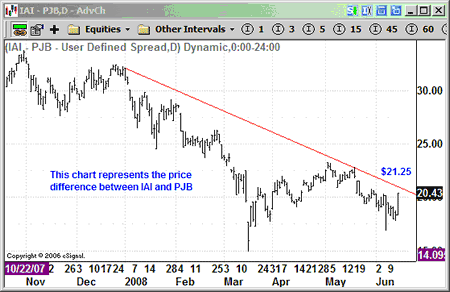
The troubles continued in the financial sector last week as Lehman Brothers (NYSE:LEH) was forced to raise $6bn in capital ($4bn in shares and $2bn in convertible stock) just to keep its head above water. This increased the firm’s shares outstanding by 25%.
The stock, issued at $28 a share, quickly dropped below $22 before rebounding on Friday to close at $25.81. This is just another sign that investors remain very concerned about the financial sector. What’s interesting, however, is that more banks made new lows last week than brokerages.
A spread chart of the iShares DJ Broker-Dealers (AMEX:IAI) and the PowerShares Dynamic Banking ETF (AMEX:PJB) shows a jump of about 10%, which means that the brokers outperformed the banks. Take a look…
Spread charts are really quite simple. They plot the difference in price between two different stocks. In this case, it shows the price of PJB subtracted from IAI.
A rising price means the brokers (IAI) are outperforming the banks (PJB). Conversely, if the spread price is dropping, it means the banks are outperforming the brokers.
Accordingly, last Friday’s 10% jump in the spread demonstrates the brokers’ recent strength over banks. What’s more, the spread is approaching the downtrend line, currently at $21.25, drawn from December of last year. If the spread can close above the downtrend line (I’d like to see two closes), it should continue to move higher.
A profitable, low-risk route into the financial sector
With the major brokerage companies due to release their second-quarter earnings over the next couple of weeks, followed by the larger banks in July, we should have a much clearer picture on where financial stocks are headed once the earnings hit the tape.
I suspect most of the banks and brokerage companies will use this quarter’s earnings to purge all of the bad news they currently know about. And they’ll try to put an end to the rampant speculation about more failures, like the one we saw with Bear Sterns.
Although, even if they do put all their cards on the table, there’s no guarantee that the stocks will rally.
So how can we use the bank/broker spread information to make some money? It’s called ‘pairs trading‘.
Simply put, pairs trading has the potential to achieve profits through simple and relatively low-risk positions. The pairs trade is market-neutral, meaning the direction of the overall market does not affect its win or loss. The goal is to match two highly correlated securities (IAI and PJB), trading one from the long side the other from the short side.
As such, if the IAI/PJB spread can close above the downtrend line, buying IAI and shorting PJB (in equal amounts of equity) could be a profitable, low-risk play in the financial sector. If so, the first resistance level comes in around $25.50.
• By Jim Stanton for the Smart Profits Report